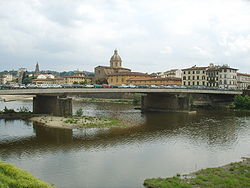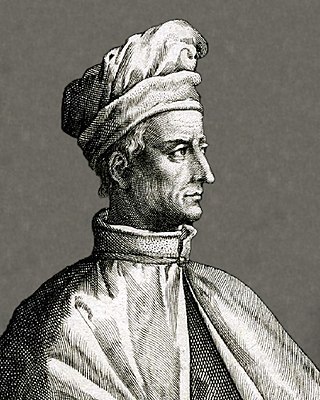
Amerigo Vespucci was an Italian explorer and navigator from the Republic of Florence, from whose name the term "America" is derived.
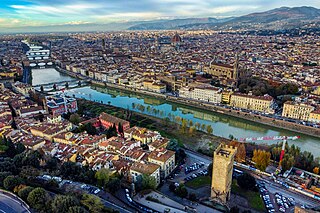
The Arno is a river in the Tuscany region of Italy. It is the most important river of central Italy after the Tiber.

The Ponte Vecchio is a medieval stone closed-spandrel segmental arch bridge over the Arno, in Florence, Italy. The only bridge in Florence spared from destruction during World War II, it is noted for the shops built along it; building shops on such bridges was once a common practice. Butchers, tanners, and farmers initially occupied the shops; the present tenants are jewellers, art dealers, and souvenir sellers. The Ponte Vecchio's two neighbouring bridges are the Ponte Santa Trinita and the Ponte alle Grazie.

Ponte alle Grazie is a bridge, reconstructed after 1945, over the Arno River in Florence, region of Tuscany, Italy.
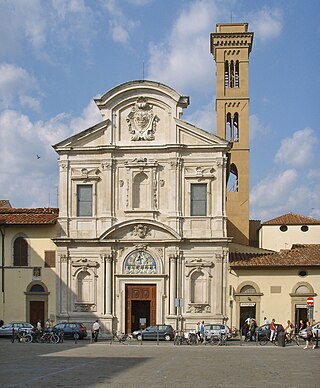
The chiesa di San Salvatore di Ognissanti, or more simply chiesa di Ognissanti, is a Franciscan church located on the piazza of the same name in central Florence, region of Tuscany, Italy. Founded by the lay order of the Umiliati, the church was dedicated to all the saints and martyrs, known and unknown.

The Ponte Santa Trinita is a Renaissance bridge in Florence, Italy, spanning the Arno. The Ponte Santa Trìnita is the oldest elliptic arch bridge in the world, characterised by three flattened ellipses. The outside spans each measure 29 m (95 ft) with the centre span being 32 m (105 ft) in length. The two neighbouring bridges are the Ponte Vecchio, to the east, and the Ponte alla Carraia to the west.

The Vasari Corridor is an elevated enclosed passageway in Florence, central Italy, connecting the Palazzo Vecchio with the Palazzo Pitti. Beginning on the south side of the Palazzo Vecchio, it joins the Uffizi Gallery and leaves on its south side, crossing the Lungarno dei Archibusieri, then following the north bank of the River Arno until it crosses the river at Ponte Vecchio. At the time of construction, the corridor had to be built around the Torre dei Mannelli, using brackets, because the tower's owners refused to alter it. The corridor conceals part of the façade of the Church of Santa Felicità. It then snakes its way over rows of houses in the Oltrarno district, becoming narrower, to finally join the Palazzo Pitti. The corridor's full length is approximately one kilometre.
Piazzale Michelangelo is a square with a panoramic view of Florence, Italy, located in the Oltrarno district.

Fabrizio de Miranda was an Italian bridges and structural engineer and university professor.

Indiano Bridge is the first earth-anchored cable-stayed bridge in the world. It is a bridge across the Arno River in Florence (Italy).

The Ponte alla Carraia is a five-arched bridge spanning the River Arno and linking the district of Oltrarno to the rest of the city of Florence, Italy. To the west is a weir, the Pescaia di Santa Rosa, and the Ponte Amerigo Vespucci, and to the east is the Ponte Santa Trinita. The piazzas on either bank are the Piazza Nazario Sauro (south) and the Piazza Carlo Goldoni (north). At the northernmost column of the bridge a family of coypus live in a dam.
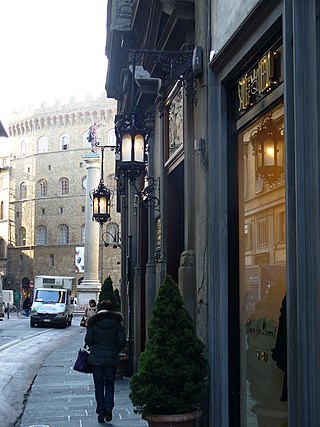
Via de' Tornabuoni, or Via Tornabuoni, is a street at the center of Florence, Italy, that goes from Antinori square to Ponte Santa Trinita, across Santa Trinita square, distinguished by the presence of fashion boutiques.

The Tower or Torre dei Rossi-Cerchi is a reconstructed medieval tower, now part of the B&B Hotel Pitti Palace al Ponte Vecchio, located on Via Guicciardini, corner Borgo San Jacopo, in the Oltrarno district near the entrance to the Ponte Vecchio in Florence, region of Tuscany, Italy.
The following is a timeline of the history of the city of Florence, Tuscany, Italy.

The Column of Santa Felicita is a monumental column with Corinthian capital standing in front of the church of Santa Felicita in Florence, region of Tuscany, Italy.
The Palazzo Tempi, also known as Palazzo Vettori or Bargagli Petrucci, is a palace located along the Arno river at the narrow Piazza Santa Maria Soprarno 1, corner with Via de' Bardi and Costa dei Magnoli in the Oltrarno section of Florence, Tuscany, Italy. The palace is across the river from the Galleria of the Uffizi, and a block east of the Ponte Vecchio. The Via de' Bardi originates in an arch under the building.

Palazzo Serristori is a Renaissance style palace located between Piazza Demidoff and the Lungarno Serristori in Oltrarno, in the neighborhood of San Niccolò of Florence, region of Tuscany, Italy.
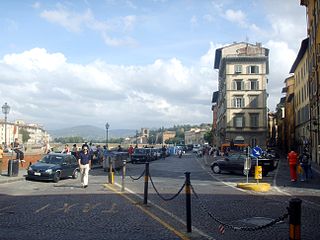
Lungarno Torrigiani is the stretch of the south bank of the Arno river in Florence that goes from Via de 'Bardi to the Ponte alle Grazie. From the Lungarno, there's an extraordinary view of the Uffizi, the Vasari Corridor and Ponte Vecchio.
Giuseppe Giorgio Gori was an Italian architect.
